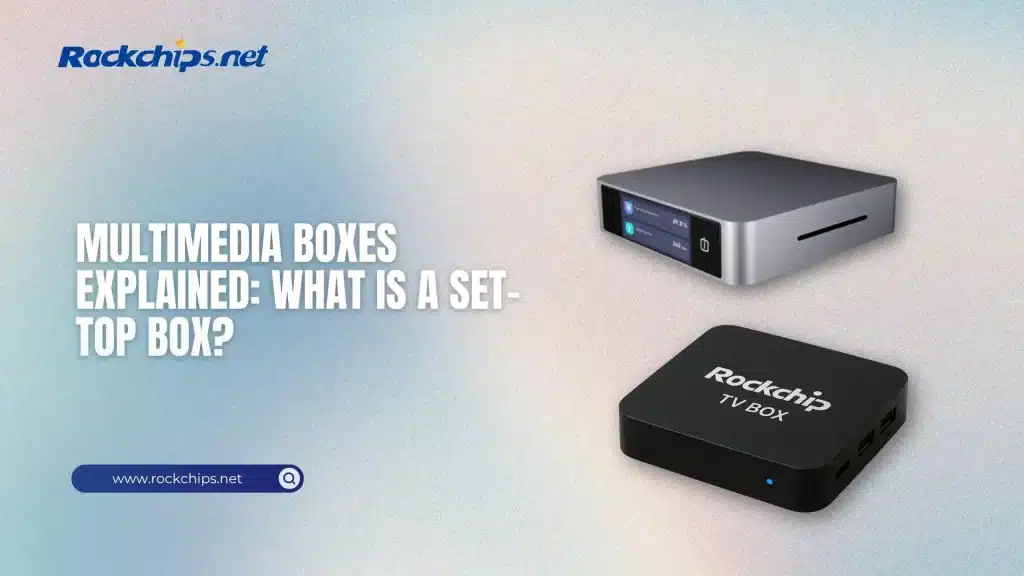
Multimedia boxes – sometimes called set-top boxes, smart boxes, or streaming media players – turn ordinary TVs into flexible entertainment hubs. They range from low-cost streaming sticks to powerful Android TV / Linux-based media devices, as well as single-board-computer (SBC) solutions used in custom products. This guide explains what a set-top box is, how multimedia boxes differ, practical use cases, a comparison table to help choose, and how we can build customized TV-boxes, smart-boxes, smart-devices and SBCs based on Rockchip solutions for OEM/ODM customers.
What is a set-top box / multimedia box?
A set-top box (STB) is an external device that receives content (cable, satellite, antenna, or internet) and converts it into video and audio a TV can display. Historically STBs were primarily tuners and decoders; modern devices additionally run apps, stream cloud content, record programs, and provide interactive guides – in short, they’re small general-purpose multimedia computers attached to your television.
The term multimedia box is broader and often used to emphasize streaming, media playback, and smart features. A multimedia box might be an Android TV box, a dedicated IPTV receiver, or a small form-factor device that supports 4K/8K decoding, HDR, and hardware codecs for efficient video playback. Energy, form factor, and OS support vary across the range.
Multimedia boxes. Core components and capabilities
Typical multimedia boxes include:
- System on Chip (SoC) with CPU, GPU and VPU for decoding (e.g., Rockchip RK series).
- Memory & storage (RAM + eMMC/flash/SD).
- Networking (Ethernet and/or Wi-Fi, sometimes Bluetooth).
- Video outputs (HDMI supporting 4K/8K, HDR).
- Software stack (Android TV, AOSP variants, Linux, or custom middleware).
Modern boxes often add hardware video acceleration (HEVC, AV1), DRM support, and AI features such as upscaling or voice assistants. Rockchip is a widely used SoC vendor in this space, offering families of processors targeted at TV boxes and SBCs.
Typical use cases
- Home streaming: Turn a legacy TV into a smart TV for Netflix, YouTube, and apps.
- Set-top distribution: ISPs and MVPDs deliver managed services (live TV + VOD).
- Digital signage & kiosks: Multimedia boxes drive displays in commercial settings.
- IoT / embedded devices: SBC variants are used where custom hardware and I/O are required (e.g., hospitality or industrial interfaces).
- Edge computing & AI-assisted playback: Higher-end SoCs enable local processing like AI upscaling or camera/vision tasks.
Comparison table – quick selection guide
(Table notes: “SoC” examples and features vary by vendor and generation; use case mapping is indicative and should be validated against the latest product datasheets.)
Choosing the right multimedia box: practical tips
- Match video features to your display – 4K/HDR monitoring requires a box with the right VPU and HDMI version.
- Consider codecs & DRMs – If you use paid streaming services, ensure the box supports required DRM (Widevine L1, PlayReady).
- Network & storage – For VOD and multiroom setups, prefer gigabit Ethernet and adequate local storage (or NAS support).
- Long-term updates & security – Choose devices from vendors with a track record of updates or plan for managed updates in custom deployments.
- Customization & integration – For large deployments or differentiated products, an OEM/ODM approach with a customizable Rockchip-based platform can speed time to market. Rockchip family SoCs are widely used in TV-box OEM designs and offer scalable performance across product tiers.
Why many OEMs choose Rockchip platforms
Rockchip provides a range of SoCs tailored to multimedia and embedded applications (e.g., RK3328, RK3288 historically, and RK3588 more recently). These chips balance multimedia decoding, connectivity, and cost, and are commonly used by OEMs to build Android TV boxes, smart boxes, and SBCs. Rockchip’s ecosystem – reference boards, firmware, and vendor tools
Our customization services (TV-boxes, Multimedia boxes, smart-boxes, Smart-devices, SBCs)
We offer end-to-end product customization and manufacturing services for clients who need branded or white-label multimedia hardware:
- Custom TV-boxes / Android smart-boxes – tailored hardware configurations (RAM, storage, network), UI/launcher branding, preloaded apps and DRM provisioning.
- Smart-devices & commercial media players – for digital signage, hospitality, education; options include remote device management, image provisioning, and specialized I/O.
- Single-board-computers (SBCs) – custom SBC designs based on Rockchip SoCs for embedded and industrial applications, with optional camera interfaces, GPIO expansion, and custom bootloaders.
- Firmware & middleware – Android builds, Linux/Yocto images, OTA update systems, security hardening and certification support.
- Regulatory & manufacturing support – help with CE/FCC testing, supplier management, and production scaling.
We commonly base designs on Rockchip solutions because they provide flexible multimedia capabilities and a robust OEM ecosystem – from low-cost 4K platforms to high-performance RK3588-class SoCs capable of advanced video and AI features. For product examples and technical details on Rockchip TV-box solutions, see Rockchip resources and product guides.
Sources
For technical background and further specification checks:
- Wikipedia – Set-top box overview and history. Wikipedia
- Samsung Support – Consumer-Facing Explanation of Set-Top Boxes and Tuner Types.
- Rockchip TV box guides, RK3588 and product customization notes. (coverage of Rockchip DIY/OEM ecosystem).
- TechRadar – Buyer’s guides and model comparisons for Android TV boxes (useful for current market context).
- Rock-Chips (press releases / SoC pages) – historical RK3328 / RK series technical briefs.
Conclusion
Multimedia boxes and set-top boxes remain central to how people access TV and streaming content. Whether you need a simple consumer streaming stick, a high-end 4K/8K media hub, a managed set-top box for service delivery, or a custom SBC for embedded applications, the right platform depends on target features (codec support, DRM, connectivity), update/security needs, and cost. Rockchip-based solutions cover a wide spectrum of performance and are a common choice for OEMs and integrators seeking customizable, multimedia-focused silicon. If you’re planning a product or deployment, we can design and deliver custom TV-boxes, smart-boxes, smart-devices or SBCs based on Rockchip platforms – including hardware, firmware, UI branding, and production support – to meet your technical and commercial requirements.
Read more articles:



